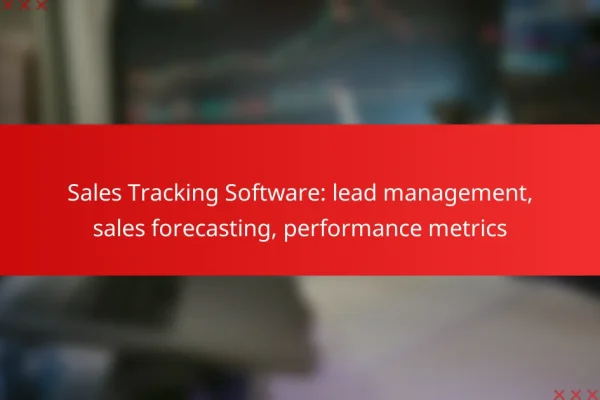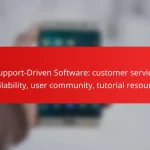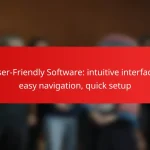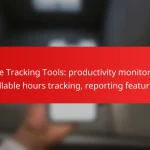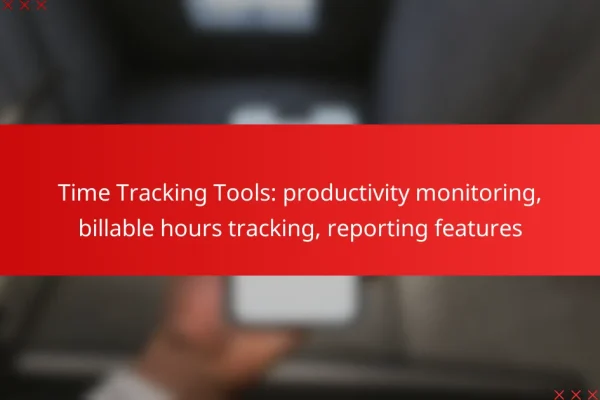How can handheld software improve efficiency in remote work?
Handheld software enhances efficiency in remote work by enabling seamless access to tools and resources from anywhere. This flexibility allows workers to manage tasks, collaborate in real-time, and track their time effectively, leading to improved productivity.
Task management tools
Task management tools help remote teams organize and prioritize their work. These applications allow users to create to-do lists, set deadlines, and assign tasks to team members, ensuring everyone is on the same page. Popular options include Trello, Asana, and Todoist, which offer features like drag-and-drop functionality and customizable workflows.
When selecting a task management tool, consider ease of use and integration with other software. Look for features such as notifications and progress tracking to keep everyone accountable and informed.
Real-time collaboration apps
Real-time collaboration apps facilitate instant communication and teamwork among remote workers. Tools like Slack, Microsoft Teams, and Zoom enable users to share files, hold video meetings, and chat in real-time, which helps maintain a sense of connection and engagement.
Choose collaboration apps that suit your team’s size and communication style. Ensure that the tools support various devices and platforms to accommodate all team members, enhancing overall workflow and reducing delays.
Time tracking solutions
Time tracking solutions are essential for monitoring productivity and managing workloads effectively. Applications such as Toggl, Harvest, and Clockify allow users to log hours spent on tasks, providing insights into work patterns and helping identify areas for improvement.
When implementing time tracking, encourage transparency and regular check-ins to discuss findings. This practice can help teams optimize their schedules and allocate resources more efficiently, leading to better project outcomes.
What are the best handheld software options for businesses?
Some of the best handheld software options for businesses include Trello, Asana, and Slack. These tools enhance productivity and streamline communication, making them essential for efficient operations.
Trello
Trello is a visual project management tool that uses boards, lists, and cards to organize tasks. It allows teams to track progress in real-time, making it easy to see what needs attention at a glance.
When using Trello, consider setting up boards for different projects and utilizing labels for prioritization. This helps in managing workflows effectively. A common pitfall is overcrowding boards with too many tasks, which can lead to confusion.
Asana
Asana is designed for task management and team collaboration, offering features like project timelines and task assignments. It helps teams stay aligned on goals and deadlines, ensuring accountability.
To maximize Asana’s effectiveness, create clear project templates and regularly update task statuses. Avoid vague task descriptions, as clarity is crucial for team members to understand their responsibilities. Integrating Asana with other tools can further enhance its functionality.
Slack
Slack is a messaging platform that facilitates real-time communication among team members. It supports channels for different topics, direct messaging, and file sharing, making it a hub for collaboration.
To optimize Slack usage, establish guidelines for channel organization and encourage the use of threads to keep conversations focused. Be cautious of notification overload, which can lead to distractions; consider setting specific times for checking messages. Integrating Slack with other software can streamline workflows further.
How to choose the right handheld software for your team?
Choosing the right handheld software for your team involves understanding your specific needs, assessing integration options, and ensuring a user-friendly experience. Focus on solutions that align with your team’s size and workflow to maximize productivity.
Assess team size and needs
Start by evaluating the size of your team and the specific tasks they perform. Larger teams may require software that supports multiple users and offers robust collaboration features, while smaller teams might benefit from simpler, more cost-effective solutions.
Consider the types of tasks your team will be performing with the software. For example, if your team needs to manage inventory, look for software that includes inventory tracking and reporting capabilities.
Evaluate integration capabilities
Integration with existing tools is crucial for seamless workflow. Check if the handheld software can connect with your current systems, such as CRM, ERP, or project management tools. This can save time and reduce the learning curve for your team.
Look for software that offers APIs or built-in integrations with popular platforms. This will help ensure that data flows smoothly between applications, enhancing overall efficiency.
Consider user interface and experience
A user-friendly interface is essential for quick adoption and effective use of handheld software. Choose software that has an intuitive design, allowing team members to navigate easily without extensive training.
Test the software with a small group of users to gather feedback on usability. Pay attention to how quickly they can complete tasks and whether they encounter any obstacles. This can provide valuable insights into the software’s effectiveness for your entire team.
What are the pricing models for handheld software?
Handheld software typically employs various pricing models, each catering to different user needs and preferences. Understanding these models can help you choose the most cost-effective solution for your requirements.
Subscription-based pricing
Subscription-based pricing involves paying a recurring fee, usually monthly or annually, to access the software. This model often includes regular updates and customer support, making it a convenient option for users who prefer not to manage software installations manually.
Costs can vary widely, ranging from a few dollars to several hundred dollars per month, depending on the software’s features and the number of users. It’s essential to evaluate whether the ongoing costs align with your budget and usage needs.
Freemium models
Freemium models allow users to access basic features of the software for free, with the option to upgrade to a paid version for additional functionalities. This approach is beneficial for users who want to test the software before committing financially.
While the free version may suffice for casual users, businesses often find that premium features, such as advanced analytics or enhanced support, are necessary for optimal performance. Be cautious of hidden costs that may arise when upgrading.
One-time purchase options
One-time purchase options require users to pay a single fee for lifetime access to the software. This model can be appealing for those who prefer to avoid ongoing costs and want full ownership of the software.
However, consider that one-time purchases may not include future updates or support, which could lead to additional expenses down the line. Ensure you assess the long-term value and potential need for upgrades before making a decision.
How can handheld software enhance productivity tracking?
Handheld software can significantly enhance productivity tracking by automating data collection and providing real-time insights. This allows users to monitor their performance more effectively and make informed decisions quickly.
Automated reporting features
Automated reporting features streamline the process of tracking productivity by generating reports without manual input. Users can schedule reports to be created daily, weekly, or monthly, ensuring they always have up-to-date information at their fingertips.
For example, a sales team using handheld software can receive automated sales reports that highlight performance metrics, allowing them to identify trends and adjust strategies promptly. This reduces the time spent on data entry and increases focus on actionable insights.
Integration with analytics tools
Integration with analytics tools enhances the capabilities of handheld software by allowing users to visualize their productivity data. By connecting to platforms like Google Analytics or Tableau, users can create custom dashboards that reflect their specific goals and performance indicators.
Consider a project manager who integrates their handheld software with a project management tool. This integration can provide insights into task completion rates and resource allocation, helping to optimize workflows and improve overall efficiency. Ensuring compatibility with existing tools is crucial for maximizing these benefits.
What are the common challenges with handheld software?
Handheld software often faces several challenges that can hinder its effectiveness. Key issues include data security concerns, integration issues with existing systems, and limited offline functionality.
Data security concerns
Data security is a significant challenge for handheld software, especially when sensitive information is involved. Users must ensure that data is encrypted both in transit and at rest to prevent unauthorized access.
Implementing strong authentication measures, such as two-factor authentication, can help mitigate these risks. Regular software updates and adherence to security standards, like GDPR or HIPAA, are also essential for maintaining data integrity.
Integration issues
Integration issues arise when handheld software needs to work with existing systems or databases. Compatibility problems can lead to data silos, where information is not shared effectively across platforms.
To address integration challenges, it is crucial to choose software that supports common APIs and data formats. Conducting thorough testing before deployment can also help identify potential integration obstacles early on.
Limited offline functionality
Many handheld software solutions struggle with limited offline functionality, which can hinder productivity in areas with poor connectivity. Users may find themselves unable to access critical features or data when not connected to the internet.
To improve offline capabilities, consider software that allows for local data storage and synchronization when connectivity is restored. This approach ensures that users can continue working seamlessly, regardless of their internet access.
What are the emerging trends in handheld software for efficiency?
Emerging trends in handheld software focus on enhancing productivity through automation, integration, and user-friendly interfaces. These advancements aim to streamline tasks, reduce manual input, and improve overall user experience.
Integration with IoT Devices
Handheld software increasingly integrates with Internet of Things (IoT) devices to enhance operational efficiency. This integration allows users to control and monitor various devices directly from their handheld devices, creating a seamless workflow. For example, a warehouse manager can track inventory levels in real-time using a mobile app linked to smart shelves.
When considering IoT integration, ensure compatibility with existing systems and prioritize security to protect sensitive data. Regular updates and maintenance are essential to keep the software functioning optimally with connected devices.
Artificial Intelligence and Machine Learning
Artificial intelligence (AI) and machine learning (ML) are becoming integral to handheld software, enabling predictive analytics and personalized user experiences. These technologies can analyze user behavior and suggest actions, significantly reducing decision-making time. For instance, a sales app might recommend products based on previous purchases.
To leverage AI and ML effectively, choose software that offers robust data analytics capabilities. Be mindful of data privacy regulations, especially when handling customer information, to ensure compliance with local laws.
Enhanced User Interfaces and Experience
Modern handheld software emphasizes intuitive user interfaces (UI) to improve user experience (UX). Simplified navigation, customizable dashboards, and responsive design are key features that help users accomplish tasks quickly. For example, a project management app may offer drag-and-drop functionality for task assignments.
When selecting software, prioritize options that provide user-friendly interfaces and allow for customization to fit specific workflows. Regular user feedback can guide further improvements and ensure the software meets evolving needs.
Cloud-Based Solutions
Cloud-based handheld software solutions are gaining traction due to their flexibility and accessibility. Users can access data and applications from anywhere, facilitating remote work and collaboration. This is particularly beneficial for teams that operate across different locations.
Consider the cost of cloud services, as subscription models can vary widely. Ensure that the chosen solution offers sufficient storage and complies with data security standards relevant to your industry.
